The 4th day of God’s work
The sun, the moon, the stars
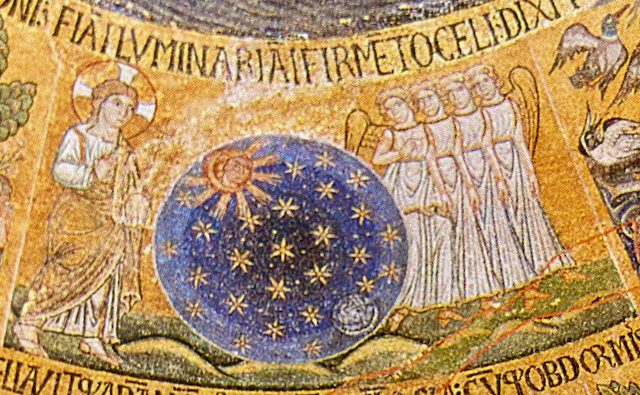
The 4th day, dome of Genesis. Basilica of San Marco, Venice (13th century). The saints, the martyrs, shine like stars in the sky, victorious over the darkness of evil. Their love for one another unites them like members of the same body; together, like the moon, they receive their radiance from the light of the risen Christ, the sun of justice.
On the fourth day of God’s work, the luminaries separate day from night. So God is always at work to bring humanity into full likeness with him, to separate it from darkness and make it shine with his light. From the model of faith, Abraham, we know what steps this faith will take, what fruits it will bear, and what its destiny will be: for God promises Abraham: “I will make your descendants as numerous as the stars in the sky”. (Genesis 22:17). In the Bible, children represent the consequences of our actions. Abraham’s faith will give rise to a multitude of human beings who, putting their trust in God, will also be a light for this world, a landmark in the night. Indeed, Abraham is praised in the Bible for his total trust in God’s word. Saint Paul tells us that when God asked him to sacrifice his own son, Abraham was ready to do so because he believed that God, the master and origin of life, could give him back that life beyond death. How many men and women in the history of the world have been ready to sacrifice their own lives for justice, to come to the aid of their neighbor, how many have had this same confidence that a life offered out of love would have conquered death. In every tragic moment of history, a multitude of martyrs continue to bear witness to this faith in life, in love, stronger than death. For all of us, they are like stars shining in the darkness. Jesus came to strengthen the faith of human beings in the victory of love over death. After showing the greatest love by offering his life and forgiveness to all mankind on the cross, he manifested the resurrection, appeared to his disciples and sent them out into the world to bear this witness. This testimony was so fundamental to the apostles that they were ready to sacrifice their lives when someone tried to silence them about the resurrection. Jesus promised them:
” Amen, amen, I say to you: he who believes in me will do the works that I do. He will do even greater works, because I am going to the Father, and whatever you ask in my name, I will do, so that the Father may be glorified in the Son. When you ask anything in my name, I will do it. If you love me, you will keep my commandments. And I will pray the Father, and he will give you another Helper who will be with you forever: the Spirit of truth, whom the world cannot receive, for it neither sees him nor knows him; but you know him, for he dwells with you, and will be in you.” (John 14:12-17)
This Spirit will descend on the apostles on the day of Pentecost, and they in turn will be able to pass it on. This is the mystery of the Church, of the members of Christ’s body, the mystery of those who are connected to the same source of love and life, those who are one, one family of brothers and sisters, animated by the same spirit of God’s love. They are the members, and Jesus is the head, spreading his love through his members. The image of the moon speaks to us of this mystery, reflecting in the darkness the light of Christ, the sun of justice. Those who receive this light are the stars that help humanity find the source of life in the night.
The stages in the life of Jesus
The 50th day: Pentecost
The 50th year: the Sabbatical Year
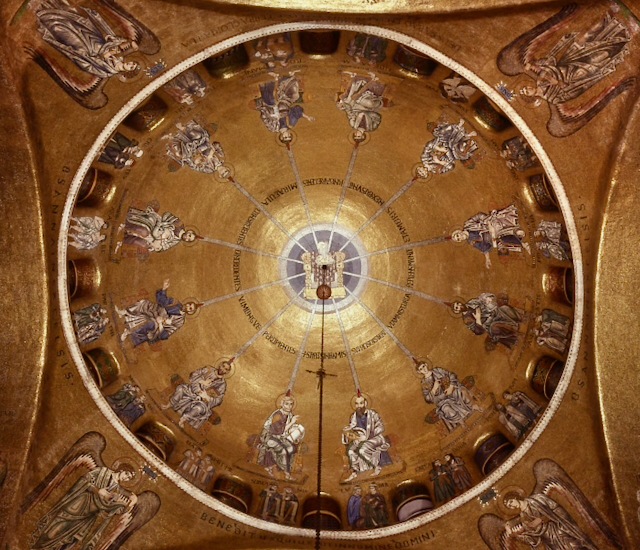
Pentecost dome. Mosaic, Basilica of San Marco, Venice (13th century). The Holy Spirit on God’s throne, in the form of a dove, pours out his love on the apostles, over whose heads he shines like a flame. Love is often represented as a flame, a fire that burns and warms the heart, but also as wisdom that spreads its light. The apostles, thus indwelt by God’s Spirit, are able to transmit it to the crowds and peoples of all languages who are represented in the outer circle of the mosaic, designated by their names.
The number fifty is very important in the Bible, designating the moment when, after so much tribulation, human beings can finally glimpse salvation, deliverance, forgiveness and the peace that follows. It’s the moment when, at last, humanity, blinded and divided, is brought back to unity, harmony and peace. All this has in fact been brought about by Jesus’ Spirit of love, which has been offered and transmitted to mankind. It had already been foretold, figuratively in the words of the Old Testament prophets, and was finally fulfilled by Jesus.
Let’s see how this was already announced in the Bible, and what images the Word of God uses to tell us about this fulfillment of our spiritual life. First of all, it is through the number seven, the number of the days of creation, that God leads us to himself, in successive stages. Seven are also the lights that God’s Spirit brings to humanity, the lights that lead us to him, to the fullness of love: wisdom, discernment, counsel, strength, knowledge, fear and contemplation of the Lord. Now, in our lives, the steps that lead us to God each time, through our trials and all the vicissitudes of our lives, are repeated again and again, ad infinitum, it seems. But, in the Hebrew language of the prophets, there are no abstract words like “infinite”, so, to imagine what this might represent in our lives, we multiply a number by itself. So, if we take the number seven, which tells us the fullness of God’s work, to mean that it happens infinitely, we would say 7 times 7 or 70 times 7. And what awaits us at the end of this life, when we’ve gone through all the stages and, after countless mistakes and countless pardons received, we’ve finally found rest? This beatitude, this happiness that will be ours when we are finally reconciled with God and with one another, is represented by the number 50. Indeed, after multiplying the number seven by itself, after making mistakes 70 times 7 times and asking forgiveness, after seeking wisdom, discernment, counsel, strength, knowledge, fear and contemplation of the Lord 70 times 7 times, we will finally arrive at the beatitude, the number that is beyond 7 times 7 (7×7= 49): this is the number 50, which tells us the achieved goal.
So, after having lived through Lent, the forty days that represent the trials of our earthly life, after having meditated on the mystery of Easter, represented by the number seven, which tells us of the accomplishment of God’s work, the work of salvation, we move on to the number 50, that of the fiftieth day, which marks the passage to happiness through reconciliation.
This was already foretold in the Bible in the prescriptions concerning the Sabbatical year, the fiftieth year that comes after counting seven times seven years: in that year, work will cease, there will be no more slaves and everyone will regain their possessions, humanity is reconciled.
The summary, the digest of the whole Bible, is found in the prayer of the Psalms, and here Psalm 50 tells us that after being forgiven countless times, the faithful, created anew, will finally be able to enjoy God’s peace and praise him with redeemed humanity.
And so we come to the fulfillment of the promises in Jesus Christ. It was on the fiftieth day after his resurrection that his spirit, his love, was finally poured out on the apostles, and through them transmitted to the rest of humanity. Indeed, Pentecost means the fiftieth in Greek, and it’s important to see what the evangelist St. Luke has to say about this day.
On this fiftieth day, the apostles were still locked up, hidden away, in the place where they had taken their last meal with Jesus. At that moment, they were given the opportunity to enter into full communion with God, to share his Spirit of love. This spiritual reality was represented by the image of flames descending on each of them. They then went out to meet the crowd who had seen the wonder of the flames in the sky and had gathered around the house. Now, there were people there from all over the world, and everyone heard the apostles speak in their own language. This miracle is important because it reminds us that mankind was divided when it set out to build a tower to rival God, the Tower of Babel. When the tower collapsed, human beings, deprived of God’s love, became rivals, and each one spoke in a different language. The miracle of Pentecost, thus, tells us that God’s love brings people together and reconciles them, and that the difference of language is no longer an obstacle. And the evangelist adds that on that day, the words of the prophet Joel were fulfilled, announcing that in the last days the Spirit of God would be poured out on every creature. Indeed, these are the last days, not in the sense of the end of the world, but in the sense that, God’s work having been accomplished on the seventh day, humanity, animated by the Spirit of God, passes on to a new life, outside this time because renewed in its spirit, which lives the reality of the Kingdom of God, of a love that unites the one who receives it with his neighbor, in whom he now sees a brother, a sister, a member of his own body.
Thus, in the mosaic of the Pentecost dome in the Church of St. Mark, not only the Holy Spirit is depicted as a dove reigning over the throne of God and sending a ray down upon the apostles, but also, all around the apostles, is depicted the multitude of different peoples listed in St. Luke’s account. Here are the various peoples present on the Day of Pentecost in Jerusalem, represented in the outer circle of the dome, two for each people: “Parthians, Medes and Elamites, inhabitants of Mesopotamia, Judea and Cappadocia, the province of Pontus and that of Asia, Phrygia and Pamphylia, Egypt and the lands of Libya near Cyrene, Romans passing through, Jews by birth and converts, Cretans and Arabs, all we hear them speak in our tongues of the wonders of God.” (Acts 2:9-11) The Latin inscription on the mosaic tells us: “Spiritus in flamis sup(er) hos distillat ut amnis corda replens munit et amoris nexibus unit hinc varie gentes miracula conspicientes fiunt credentes vim lingue percipientes”. “The Spirit descends upon them in flames, like a river which strengthens them by filling their hearts and unites them by the bonds of love. This is why various peoples observing these miracles become believers, perceiving the strength of their language.”
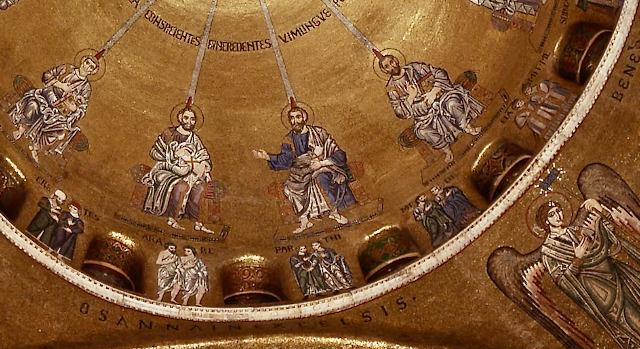
Detail of the Pentecost dome. Mosaic, Basilica of San Marco, Venice (13th century). Below the apostles, two figures represent each of the peoples and languages who were in Jerusalem that day. Each one heard the apostles speak in their own language. This miracle shows us that the division and rivalry that separated people into different languages when the Tower of Babel was built, has now been abolished by the gift of the Holy Spirit, sent to reconcile people with God. United in one love, everyone understands the language of the apostles.
The relationship with God and with our neighbor
The anointing that transmits the Spirit
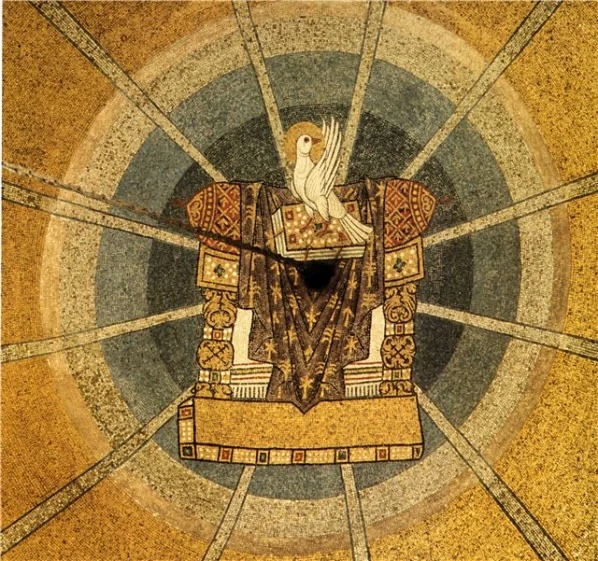
Detail of the Pentecost dome. Mosaic, Basilica of San Marco, Venice (13th century). On God’s throne, the book of his Word and the dove of the Holy Spirit. This Word became flesh, animated by God’s Spirit of love. This is not a dead letter, but a love that can transform humanity and bring it into full likeness with God. The flame of love that animated the apostles led them to lay down their lives for those they loved, making them a living reflection of Christ, of the word of God, animated by the same spirit.
Spirit is undoubtedly the most difficult human reality to represent: invisible, immaterial, what form could we give it? To represent it as such, creation offers us the image of fire. Indeed, the whole of creation receives life from the Spirit of God and is created by the Word of God, the work of the Trinity, of a God who is a relationship of love and who manifests this love through this work. So we can look for ways in which this creation manifests God’s work to us, for it is predisposed to do so. We have seen the image of light, which makes God’s face visible and knowable to us, just as Jesus Christ, God’s word made flesh, makes him visible to us. Now let’s look at that element directly associated with light, fire. Fire, like the spirit, like the breath that animates us and like the wind, has no fixed form, but it transmits light and warmth. It comes to warm cold hearts, hearts of stone, it comes to give new life to what is frozen in death, in coldness. The disciples, saddened by Jesus’ death, meet the risen Jesus on the road, but they don’t recognize him. Without being recognized, Jesus opens their minds to the Scriptures, explaining how his resurrection had already been foretold by the prophets. Finally, after inviting the stranger to stay with them, he makes himself known, but immediately disappears from their sight. Then the disciples exclaim: “Didn’t our hearts burn when he explained the Scriptures to us? Indeed, deep communion with our fellow human beings warms our hearts, and what was cold and despairing comes to life again when it is rekindled by love. In this way, love is transmitted like a flame, without losing its warmth, ad infinitum. This is the image in which the Spirit itself manifests itself before our eyes. But our own spirit has a long way to go before it is gradually purified by this Spirit of love, which is God’s Holy Spirit. And here the oil will show us all these spiritual stages, before the human being himself becomes an oil lamp, a light, a burning fire that transmits his love to others.
Let’s start at the beginning: olives, the olive tree, the olive branch. These are fundamental elements for the language of the Bible, the language of God’s Word expressed through the elements of His creation. The olive tree is the tree of reconciliation, the tree that heralds the path to peace. Unfortunately, on this earth, the road to peace will go through many tribulations. Already in the book of Genesis, we are shown through the story of the flood that after the victory over evil, more time is needed, a dove bearing an olive branch will announce that this victory has been won by God, but it is up to mankind, thereafter, to welcome the fruits of this victory. Let’s not forget that the most terrible moment in Jesus’ life was the night of his arrest in the Garden of Olives, where he was betrayed, rejected and abandoned. He suffered to the point of sweating blood, the Gospel tells us.
So let’s see why the olive tree, olives first, then oil, then the oil lamp. Indeed, before producing oil, the olives must be pressed, that is, the kernel of resistance must be broken and crushed, as the Bible says: “The sacrifice that pleases God is a broken spirit; you do not repulse, O my God, a broken and crushed heart.” (Psalm 50:19). This means that the olives have to be ground, the millstone’s job is to destroy the kernel, everything in our spirit that resists God’s will, everything that stands in the way of love for God and neighbor. It is by acknowledging our faults that we can be forgiven, that is to offer God a broken and crushed spirit, contrition, regret for our faults, for our errors, then we can be purified by him. Indeed, oil that has barely been ground is all cloudy, it needs to settle to be purified, and little by little this purified, forgiven spirit will become luminous, brilliant and golden like oil that becomes luminous even before it carries the flame. It’s on the path of this life that the human being who recognizes his mistakes can be forgiven and thus helped to learn from them and improve.
Now, oil, in addition to telling us about our spiritual path, through the process of its extraction and purification, also tells us how the spirit can penetrate us deeply. Indeed, we know how deeply oil penetrates our skin, how it softens, strengthens and warms. Water can’t penetrate stone, but the drop of oil will mark the stone it has touched by penetrating deeply into it.
So oil is the visible sign of grace, of God’s loving Spirit penetrating human beings, imparting wisdom, discernment, counsel, strength, knowledge, fear and contemplation of the Lord. It’s the element God has chosen to signify His choice and will to join with human beings to bring light and help to the world. This is the meaning of the sacraments of Holy Orders and Confirmation. The bishops, successors of the apostles, by the words of blessing pronounced over the oil, express the divine will and promise to accompany, assist, dwell in and fill his creature with his loving presence, to enable him to fulfill his mission of being the light of the world. There are therefore three types of mission through which Christ’s love for his creatures is multiplied through the human beings he has called to be a reflection of his light and mercy for everyone, three sacraments whose oil is the material that makes God’s action visible and effective in the faithful who invoke his help and grace.
The word sacrament comes from the word “sacred”, and that which is sacred is the bearer of the divine presence. Through the sacrament, a covenant is sealed between God and his creature. The believer becomes a child of light, i.e. a bearer of divine light, assisted by the spirit of God’s love, spreading this love through the same wisdom, discernment, counsel, strength, knowledge, fear and contemplation of the Lord in which God’s love unfolds. The faithful thus receive an anointing to indicate that God’s Spirit penetrates, strengthens and assists them. Three sacraments, then, express divine help and presence through oil, which becomes a visible image of the work and presence of the divine Spirit.
1. The first is the sacrament of Holy Orders, by which a bishop or priest is ordained to his mission, that is to say, he is entrusted with a ministry and receives divine assistance in carrying it out. In the first instance, it is the bishop, successor of the apostles, who receives from another bishop the anointing on the head to guide the faithful in understanding and putting into practice the faith. The anointing of the head with oil is preceded by the imposition of the hands of the other bishops on the one about to be ordained. The laying on of hands also expresses the desire to transmit the Spirit.
Next, the sacrament of Holy Orders is conferred on the future priest, who receives the anointing from the bishop. He receives it on his hands, for it is by laying his hands on the bread and wine that he will consecrate them with God’s Spirit, and also by the laying on of hands that he will transmit the Spirit to those who, by asking forgiveness for their faults, will be reconciled and filled with God’s Spirit of love.
2. Confirmation. The baptized person, who connects with the source of divine life through the element of water poured over his or her head, acknowledges that all life comes from God, and therefore undertakes to respect and serve it in every human being. For this reason, he or she will also ask to be strengthened by the anointing that transmits the gifts of the Spirit, so that he or she can be a reflection of divine mercy in this world. Every baptized person puts on Christ, takes on his mission as priest, prophet and king, i.e. he intercedes for his neighbor by assisting him, communicating the word and divine wisdom, and witnessing Christ’s victory over evil by the example of his own life. To this end, if one was baptized as a child, he or she will ask for divine help through the anointing of the Holy Spirit, so that his or her adult life is consistent with the faith and mission they intend to live. So, as an adult, they will ask to be confirmed, strengthened and assisted by the Holy Spirit, and they’ll receive once again the anointing they received at Baptism, but this time in order to make their adult life consistent with the faith they received at Baptism and now matured and assumed. They ask for the grace and strength of the Holy Spirit to be witnesses to Christ, to the life of the Kingdom, where together we form a people of brothers and sisters.
3. Anointing of the sick. Another important stage in life in which the help of God’s Holy Spirit is transmitted to us and signified by the anointing with oil is the trial of illness. Indeed, when we are weakened by illness, it is our whole spirit that needs divine help to witness Christ in weakness. Not only may we need comfort and encouragement for ourselves, but we may also need to be strengthened to bear witness to hope and trust in the Lord and his eternal life to our neighbors. Then, too, the spirit of the sick person, strengthened in this way, may recover health, or endure the ordeal of illness with patience and confidence.
Let’s not forget that the name Christ, in Greek, means the anointed one, i.e. the one whom God has chosen and entrusted with a mission. Now, the fullness of the Holy Spirit dwells in Christ, his spirit, his life, are expressions of the Spirit of God, his love is the divine love that manifests itself in his person and through his works to mankind. It is not a man who has been led by the Spirit to perfection, but the fullness of the Spirit that proceeds from the Father and the Son of God who gave life to the child Jesus in the womb of his mother Mary, thus enabling God to assume human nature, while remaining in the fullness of divine love. The term Christ is the exact translation of the Hebrew word mashiyaḥ, which is translated as Messiah, meaning exactly the one who is anointed, anointed with the divine anointing, filled with the Holy Spirit. Jesus himself will read the words of the prophet Isaiah that announce his coming and his work: “The Spirit of the Lord is upon me because the Lord has anointed me. He has sent me to bring the Good News to the poor, to proclaim release to the captives and recovery of sight to the blind, to set at liberty those who are oppressed, to proclaim a favorable year granted by the Lord.” (Luke 4:18-19). Isaiah spoke of the Messiah, the Lord’s anointed, when he enumerated the gifts of the Holy Spirit: “Upon him will rest the spirit of the Lord: the spirit of wisdom and discernment, the spirit of counsel and strength, the spirit of knowledge, of contemplation of the Lord, who will inspire him to contemplate the Lord.” (Isaiah 11:2-3).
Holy Week:
The Temple of the Holy Spirit
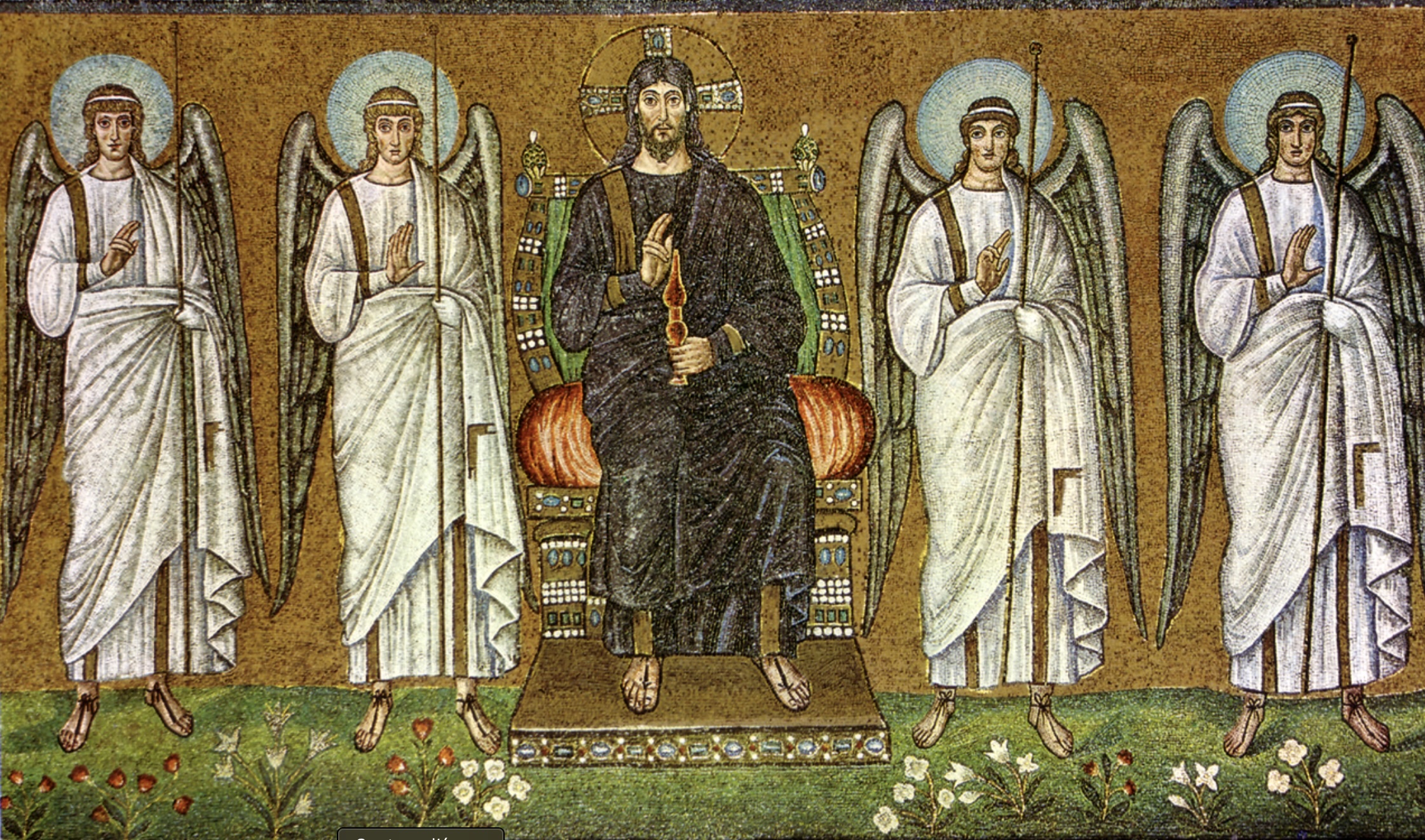
Christ, image of the Father, holds the flame of the Holy Spirit. Mosaic from Sant’Apollinare Nuovo, Ravenna (6th century). Although at first glance it’s Christ who appears on the throne, here we have an image of the Trinity. Indeed, Christ is the image of the Father: he himself said to the disciples: “He who has seen me has seen the Father”. (John 14:9). He sits on a cushion of fire, an image of the Holy Spirit, which he also holds in his hand in the shape of a flame. This is the Spirit of love that unites the Father and the Son.
During the Holy Week, Jesus comes out of the Temple, having faced the hostilities of Scripture scholars and other religious authorities, and announces the obsolescence of all the pomp and hypocrisy that hijacked religion and prayer for personal gain.
“Jesus had left the Temple and was on his way out, when his disciples came up to him and pointed out the buildings in the Temple. Then, speaking up, he said to them: “You see all this, don’t you? Amen, I say to you, not one stone will be left standing here; it will all be destroyed.” (Matthew 24, 1-2)
Having said this, Jesus also tells the apostles of terrible times ahead, when they will have to endure persecution, but he also tells them of his victory over evil. Of course, his Kingdom is not an earthly one; it is in each person’s spirit that this victory is exercised. He is coming, and he will come to establish his peace and love in the hearts of his children, having himself shown the world by his resurrection that evil and death will have no hold on him. And so he announces to the apostles that this victory over evil is offered to every human being who pursues love rather than hatred, vengeance or profit at the expense of others.
Already at the beginning of his preaching in the Temple, during his first visit with the apostles in Jerusalem, the evangelist Saint John reports the following exchange:
“Jesus answered them, “Destroy this sanctuary, and in three days I will raise it up.” The Jews replied, “It took forty-six years to build this sanctuary, and you would raise it up in three days!” But he spoke of the sanctuary of his body.” (John 2:19-21).
Indeed, by offering his own body, his own life as proof of his love, his spirit did not give way to vengeance or hatred, and evil had no power over him; on the contrary, it opened up a path of hope for mankind, as the apparent defeat was transformed into victory. Evil showed its face, and thousands of people were able to contemplate God’s face of love, finding peace and sharing victory.
This is what the prophet Ezekiel foretold centuries before, when he told us of his vision of the House of God, the Temple of God: “The man brought me back to the entrance of the House, and behold, under the threshold of the House, water gushed out toward the east, for the front of the House faced east. The water came down from under the right side of the House, south of the altar.” (Ezekiel 47:1). And the vision continues in the description of this stream which, as it flowed down the mountain, became an ever-greater river, until it became impassable. And along its banks, the trees bore fruit at all times, they never lost their leaves, and the fish in its waters multiplied in great numbers. And in the end, the river flowed into the Dead Sea, the sea of salt water where no life is possible, and the fresh water of this river made the salty waters fresh, too.
Of course, here too, we’re talking about the body of Christ, which, pierced on its right side on the cross, let water and blood flow. Christ had foretold that from his womb would flow the rivers of living water spoken of by the prophet Isaiah. Following in his footsteps, fish, disciples and believers multiplied, bearing fruit in abundance, and where there had been death in the heart, humanity was able to rediscover life, love, hope and the dignity of children of God, children of light. Evil revealed its face by condemning the innocent, and became hideous, whereas before it had seduced mankind. Jesus announces this to the disciples in the continuation of his discourse on the Temple, speaking at length about those who try to seduce mankind with deceptive words, all of which will be unmasked, revealed and the powers will fall like the stars of heaven, like false stars that had deceived people by their appearance.
In the mosaic in the church of St. Apollinaire-le-neuf in Ravenna, we see Christ revealing the loving face of the Father, who holds in his hands the flame of that love that will set the universe ablaze and make it shine with his glory, and his throne are the flames of fire of his Spirit, the Spirit of God’s love.
This Spirit of God’s love is also the Spirit who gives life to each one of us, and once we can welcome him in and through full filial trust, he makes his home in us, as Jesus himself tells us:
“Behold, I stand at the door and knock. If anyone hears my voice and opens the door, I will come in to him; I will dine with him, and he with me. I will give the victor the right to sit with me on my throne, as I myself first won the victory and sit with my Father on his throne.” (Revelation 3:20-21).
This is the meal in which we welcome the presence of Christ himself as true nourishment, his spirit of love dwelling within us, and the apostle St Paul can affirm:“Your body is the temple of the Holy Spirit, who is within you and whom you have received from God.” (1Corinthians 6:19).
Phrase of the Lord’s Prayer:
Thy will be done on earth as it is in heaven
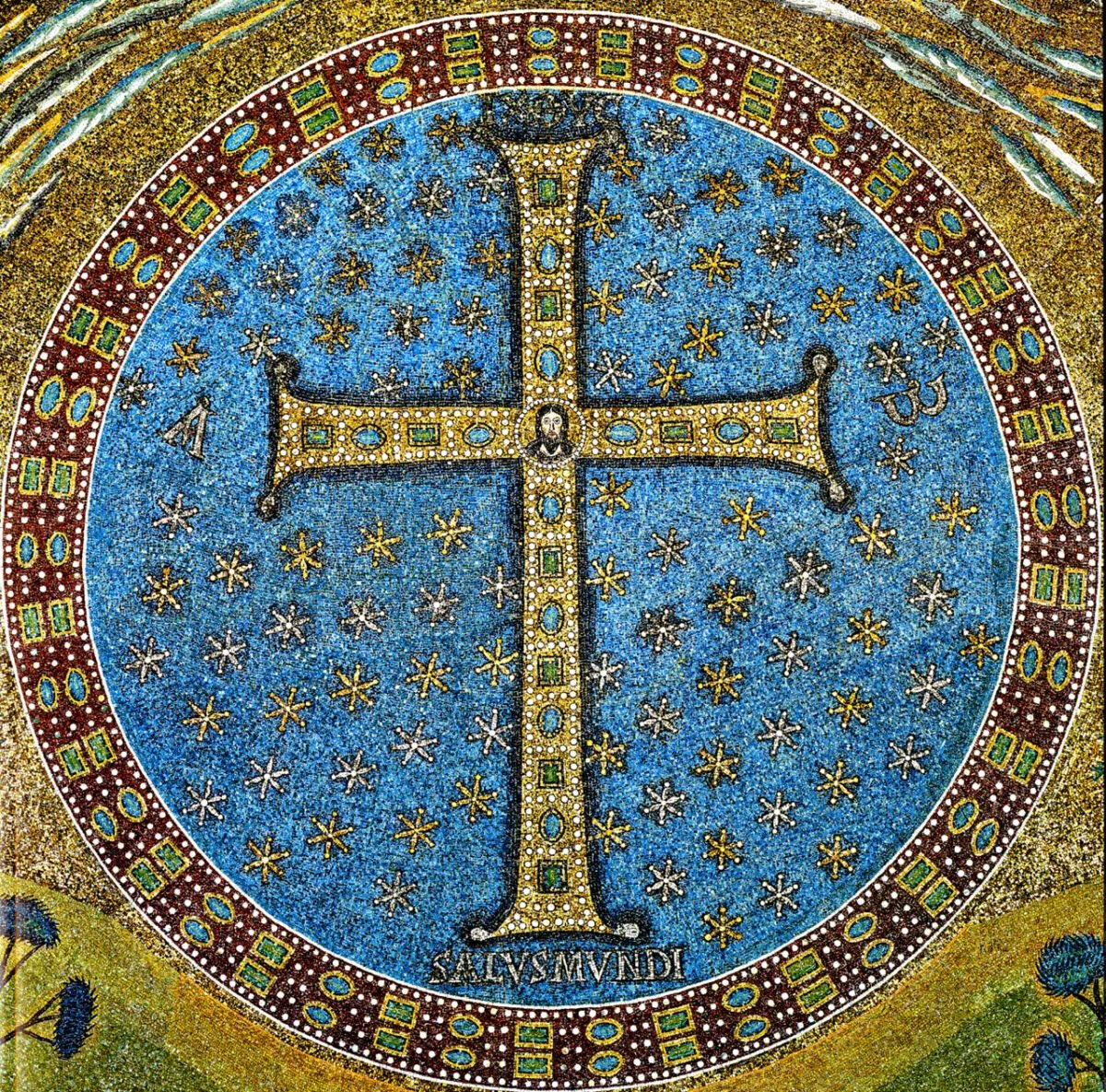
The cross, salvation of the world. Mosaic from Sant’Apollinare in Classe, Ravenna (6th century). Announcing his death on the cross, Jesus said: “The hour has come for the Son of Man to be glorified” (John 12:23), yet he was about to be crucified. This means that it is precisely on the cross, in abasement and humiliation, that Jesus will show the world God’s glory, his omnipotence. Indeed, where God is all-powerful, it is in his infinite power to forgive, it is in his mercy that all his greatness is revealed. Thus, Jesus on the cross will reveal to us the merciful face of God, who forgives his misguided children who are condemning an innocent man to protect their own interests.
This phrase from the Lord’s Prayer reveals a tension between heaven and earth, between our earthly aims of securing and preserving our life on earth, and the spiritual and eternal dimension. Indeed, abandoning our material certainties may be necessary if they put us at odds with our love of God and neighbor. Securing our lives at the expense of others cuts our bonds of brotherhood and friendship, and at the same time separates us from the only bond that is eternal: love. Indeed, what Jesus’ passion and resurrection reveal to us is that love conquers death and evil. To do this, we must be faithful to love to the end, if we are to be put to the test. This test comes from the obstinacy of human beings, from their difficulty in believing in a love that is so great, so free, so capable of preferring the happiness of others to its own. Here, then, Jesus will be put to the test, not by the will of a Father who would not believe in the sincere and profound love of his son, but by the selfish attachment of human beings to their earthly possessions, in which they place all their hope for survival. So the Father’s will will be to go all the way with love, if that’s the only way to open up a light of hope in the darkened hearts of human beings. Hearts that have become hard as stone, on which God will pour a fragrant oil to soften them, to give humanity a heart of flesh. In this way, Jesus knows very well that going to the very end of love will be the only way to show humanity that this love is its only wealth, its source of eternal life. The apostles’ witness to Christ’s resurrection was also fundamental, and they too gave their lives to pass on this testimony, as did so many Christians after them.
“I and the Father are one” (John 10:30), Jesus tells us, “for if [the Father] does anything, the Son does it too” (John 5:19), and likewise“I came down from heaven not to do my own will, but the will of Him who sent me. And this is the will of Him who sent me: that I lose none of those whom He has given me, but raise them up at the last day”. (John 6:38). In this way, Jesus shows humanity just how much God loves his children. And it is Jesus himself who is filled with the fullness of this divine love; he who is God doesn’t desire anything else, no possible contradiction between his love and that which the Father has for us. So how do we understand that, when he was ready to give himself up, to offer his life, he said: “Father, if you are willing, take this cup away from me; still, not my will but yours be done.” (Luke 22:42)? This shows us that Jesus is also fully human, and that he accepted this condition of weakness and suffering, but at what price? How much it costs him, too, to see the rejection and hostility of his children, how much it costs him to suffer the passion. To the point of blood, as the Gospel tells us: “Jesus entered into agony and prayed so fervently, and his sweat became like drops of blood falling to the ground”. (Luke 22:44). However, if there had been any other way to reveal to men the immensity of God’s love, the immensity of his glory, of course he would have preferred it. But he will trust the Father that this is the only possible way to show humanity the greatest love. Already, at the last supper, he had said: “Greater love has no one than this, than to lay down one’s life for those one loves” (John 15:13), and also: ” Amen, amen, I say to you, unless a grain of wheat falls into the earth and dies, it remains alone; but if it dies, it bears much fruit ” (John 12:24). All the prophets had foretold this, and he too had announced his imminent death to the apostles several times. But it’s a painful journey, and he shows us how important it is for human beings to trust in the One who gave us life and will give it back to us after death. This is the faith of Abraham, who also believed that, having miraculously received his son’s life from God, God could give it back to him beyond death (Romans 4:17-18). In this way, Jesus shows us the path of trust, of prayer, of victory over evil and death, making us children of the light against whom darkness will have no power. By placing our lives in the hands of the Father, we can be supported and strengthened by the Father and his angels, just as Jesus was. This too is revealed to us by the deeds of so many martyrs who offered their lives to manifest the glory of God.
So, God’s will is done on earth as it is in heaven, and when our hearts are filled with unconditional love for all human beings, even our enemies, then the Kingdom of God is in our hearts, an invincible light that darkness cannot resist. This gesture of trust that Jesus shows us is not only necessary when we offer our lives in witness, but also in our daily lives, even in the little things we can be faithful to love, choosing love sometimes at the expense of our material interests. This is what it means to be martyrs, for the Greek word simply means “witness”.
These are the stories of Jesus’ agony in the Garden of Ghetsemani, the Garden of Olives, where God’s spirit and life were to be pressed to lead mankind to be the light of the world, children of light, to become the oil that brings the good odor of Christ to the world, because oil can also let the fragrance of God’s love penetrate us.
This moment in Christ’s life is so fundamental for guiding us into eternal life right now, that every evangelist relates it. Saint John recalls Jesus’ words during the meal, which foretold this difficult hour:
“Then Jesus said to them, ‘The hour has come for the Son of Man to be glorified. Amen, amen, I say to you: if a grain of wheat falls into the ground and does not die, it remains alone; but if it dies, it bears much fruit. He who loves his life loses it; he who separates himself from it in this world will keep it for eternal life. If anyone wishes to serve me, let him follow me; and where I am, there shall my servant be also. If anyone serves me, my Father will honor him. Now my soul is overwhelmed. What shall I say? “Father, save me from this hour? – But no! That’s why I’ve come to this hour! Father, glorify your name! Then a voice came from heaven, saying, “I have glorified it, and I will glorify it again.” Hearing it, the crowd standing around said it was a thunderclap. Others said, “It was an angel who spoke to him.” But Jesus replied, “The voice was not for me, but for you. Now is the judgment of this world; now is the prince of this world to be cast out; and I, when I am lifted up from the earth, will draw all men to myself.” By this he meant what kind of death he was going to die.” (John 12:23-33)
Saint Matthew gives us the details of this night in the Garden of Olives, and Saint Mark also reports them:
“Then Jesus came with them to an estate called Gethsemane and said to them, “Sit here, while I go over there to pray.” He took Peter with him, along with James and John, the two sons of Zebedee, and began to feel sadness and anguish. So he said to them: “My soul is so sad even to death. Stay here and watch with me. Going a little further, he fell face down in prayer, and said, “My Father, if it is possible, may this cup pass from me! However, not as I will, but as you will.” Then he returned to his disciples and found them asleep; he said to Peter: “So, you didn’t have the strength to watch just one hour with me? Watch and pray, lest you enter into temptation; the spirit is fiery, but the flesh is weak.” Again he went away and prayed, for the second time; he said, “Father, if this cup cannot pass without my drinking it, thy will be done!” Returning to the disciples, he again found them asleep, for their eyes were heavy with sleep. Leaving them, he again went away and prayed for the third time, repeating the same words. Then he returned to the disciples and said: “Now you can sleep and rest. Behold, the hour is at hand when the Son of Man will be delivered into the hands of sinners. Arise! Get up! Behold, he who betrays me is near! (Matthew 26:36-46)
Finally, Saint Luke, always attentive to the human dimension of Christ, tells us just how much he suffered:
“Jesus went out, as was his custom, to the Mount of Olives, and his disciples followed him. When he got there, he said to them, “Pray that you do not enter into temptation. After withdrawing about a stone’s throw from them and kneeling, he prayed, saying: “Father, if you are willing, remove this cup from me; nevertheless, not my will but yours be done.” Then an angel appeared from heaven, comforting him. Entering agony, Jesus prayed more insistently, and his sweat became like drops of blood falling to the ground. Then Jesus rose from his prayer and joined his disciples, whom he found asleep, overwhelmed with sadness.” (Luke 22:39-45).
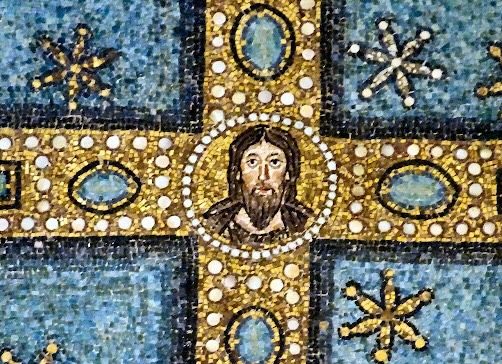
Detail of Christ’s face. Mosaic from Sant’Apollinare in Classe, Ravenna (6th century). Alive on the cross, revealing to us the true face of the Father, merciful and victorious over evil and death through the superabundance of his love. Light has conquered darkness.